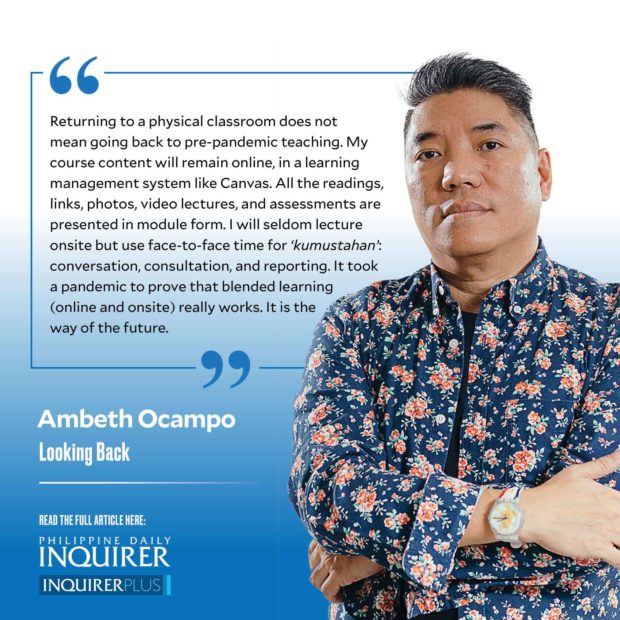Blended learning
I have taught completely online for the past two years, and while I am weary of Zoom, there are many things learned in the pandemic lockdown that I am not willing to give up.
I have only met students face to face thrice since April 2020. Twice, I offered a purely voluntary onsite Intramuros tour. While most students opted to explore the walled city through the Intramuros Administration webpage, vaccinated and boosted students decided to live with rather than hide from COVID. I was flattered that a handful of students from outside Manila (Cebu, Iloilo, Zamboanga, Baguio) were sent by their parents who decided a morning spent walking around Intramuros with me was worth the risk. Energy in those walks did not emanate from me, but from students excited to meet with their classmates.
Two years is a long time, and while educational content can be imparted online, we all know that what we truly learn in a physical classroom does not come from course content but from social interaction, not quite the same on Zoom. Although my course is completely online, I met my class face to face, since the majority are already learning onsite at the Ateneo Loyola Heights campus.
This term, I have two supersized, “magisterial” classes, one with 81 students and another with 74. I did not lecture that day. I didn’t even bring my laptop to flash the five-question quiz for the day. I deluded myself into thinking that all a good teacher needs is a voice and a board. I had lost practice writing on a board, more so in an auditorium, where physically distanced students strained to decipher my illegible handwriting. Students were not prepared for a paper quiz and had to make do with paper from their notebooks, paper from a seatmate, even paper wrapper from a half-consumed sandwich.
The “quiz” was not graded, it was merely an outline of the five points I wanted to discuss, and if I didn’t get any volunteers for recitation, my default strategy would be to call students at random and read out what their seatmates wrote down on their quiz.
Unlike Zoom that provides the names of the students, the auditorium was a sea of masked faces. To break the ice, I called out students seated in the back from text on their shirts: Ateneo, Marvel, Emirates, and Barcelona. After the initial hesitation, people started to share. If they didn’t, I was prepared to call people by the brands they wore: Fred Perry, Lacoste, Pilibustero, Uniqlo, and Bench. As freshmen straight out of basic education, many had to be told that, in university, we don’t rise but recite seated. Furthermore, they should speak to their classmates, not the professor who is just a facilitator.
Students today are more visual, research is summarized in infographics, reports are sent as videos rather than printed on paper. Two decades ago, when we used slides on a carousel or acetate on an overhead projector, reports were straightforward, the group went to the front and each member read a different part of the printed paper. More creative types acted out their reports in skits. At one point, I prohibited the use of pets and live flames in class. In a report on religious rituals at the Spanish contact, muffled squealing emanated from the back of the dark room because someone had brought a live python to class as a prop. I found out later that the student brought the coiled reptile to school daily in a gym bag. To keep it cool, the bag was deposited in the air-conditioned library. The most spectacular report on early revolts against Spanish rule had a battle that ended with the lights in the room switched off and the blackboard doused with alcohol and set ablaze. Students knew the alarm would not go off because alcohol does not emit smoke. After the wild applause, two students covered the charred part of the blackboard using chalk erasers. It was good as new.
Returning to a physical classroom does not mean going back to pre-pandemic teaching. My course content will remain online, in a learning management system like Canvas. All the readings, links, photos, video lectures, and assessments are presented in module form. I will seldom lecture onsite but use face-to-face time for “kumustahan”: conversation, consultation, and reporting. It took a pandemic to prove that blended learning (online and onsite) really works. It is the way of the future.
Comments are welcome at aocampo@ateneo.edu





















